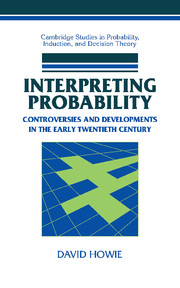Book contents
- Frontmatter
- Contents
- Acknowledgments
- 1 Introduction
- 2 Probability up to the Twentieth Century
- 3 R.A. Fisher and Statistical Probability
- 4 Harold Jeffreys and Inverse Probability
- 5 The Fisher–Jeffreys Exchange, 1932–1934
- 6 Probability During the 1930s
- 7 Epilogue and Conclusions
- Appendix 1 Sources for Chapter 2
- Appendix 2 Bayesian Conditioning as a Model of Scientific Inference
- Appendix 3 Abbreviations Used in the Footnotes
- Bibliography
- Index
7 - Epilogue and Conclusions
Published online by Cambridge University Press: 07 July 2009
- Frontmatter
- Contents
- Acknowledgments
- 1 Introduction
- 2 Probability up to the Twentieth Century
- 3 R.A. Fisher and Statistical Probability
- 4 Harold Jeffreys and Inverse Probability
- 5 The Fisher–Jeffreys Exchange, 1932–1934
- 6 Probability During the 1930s
- 7 Epilogue and Conclusions
- Appendix 1 Sources for Chapter 2
- Appendix 2 Bayesian Conditioning as a Model of Scientific Inference
- Appendix 3 Abbreviations Used in the Footnotes
- Bibliography
- Index
Summary
EPILOGUE
At the start of the 1930s, the Bayesian position was regarded at best as a model of scientific inference, and as almost useless for analyzing data. Jeffreys was determined to remedy this situation, and from 1931 set about reproducing Fisher's frequentist methods of estimation and significance-testing from a Bayesian foundation. His Theory of Probability of 1939, the first book on applied Bayesian statistics, is a collection of such analytical tools. Many were derived specially for his seismological work. The method of ‘bi-weighting,’ for example, was developed to treat the systematic displacements and unusually large numbers of outliers that resulted when data of varying reliabilities from different seismic stations were combined. With Kenneth Bullen, one of his few graduate students, Jeffreys published the fruit of this work in 1940. The Jeffreys–Bullen tables, based on countless hours spent reducing and smoothing data, related average earthquake travel times to angular distances passed through the Earth. Agreeing closely with Gutenberg's similar publication around the same time, the tables proved remarkably accurate in preserving genuine discontinuities in travel times, and are still used today to locate earthquake epicenters.
Geophysicists, however, remained more interested in Jeffreys's results than his methods; the few who thought they needed statistics at all believed least squares quite sufficient. Thus although Jeffreys maintained a steady stream of probabilistic publications after World War II, many on significance tests, his audience among physicists remained small. Nor did statisticians pay much attention.
- Type
- Chapter
- Information
- Interpreting ProbabilityControversies and Developments in the Early Twentieth Century, pp. 222 - 230Publisher: Cambridge University PressPrint publication year: 2002



